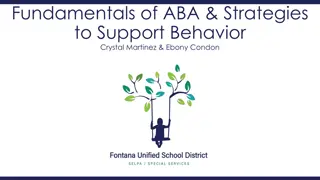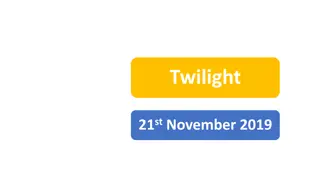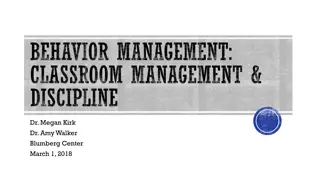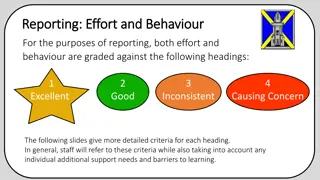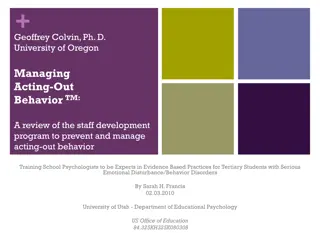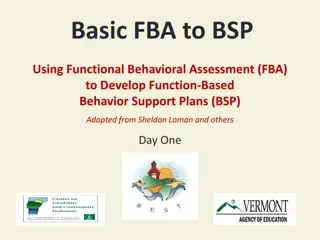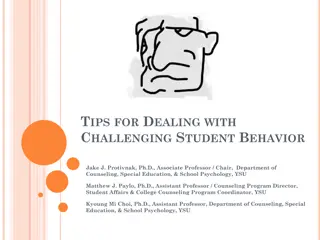
Understanding Challenging Behavior: Strategies and Insights
Gain insights into challenging behavior and its impact on education, development, and social engagement. Learn about examples, functions, and ways to navigate such behaviors effectively.
Download Presentation

Please find below an Image/Link to download the presentation.
The content on the website is provided AS IS for your information and personal use only. It may not be sold, licensed, or shared on other websites without obtaining consent from the author. If you encounter any issues during the download, it is possible that the publisher has removed the file from their server.
You are allowed to download the files provided on this website for personal or commercial use, subject to the condition that they are used lawfully. All files are the property of their respective owners.
The content on the website is provided AS IS for your information and personal use only. It may not be sold, licensed, or shared on other websites without obtaining consent from the author.
E N D
Presentation Transcript
Navigating Challenging Behavior Presented by: Amber Brown, BCBA
What is Challenging Behavior Behavior that creates risks, obstacles, or negative interference with a person s educational needs, developmental path, and social engagement
Examples of challenging behavior Aggressive behavior such as hitting, kicking, screaming etc.. Inflexibility to changes especially routines and accepting change Extreme social withdrawal Moderate to severe deficits in their ability to communicate Hyper or Hypo sensory processing
Functions of Behavior: WHY the behavior is occurring Sensory Escape Attention Access/Tangible
Sensory Engage in the behavior to meet a sensory needs. These sensory needs being met usually trigger the pleasure portion of our brains. The behavior is self satisfying and can be used to reduce discomfort and regulate. Example: nail biting, hand flapping, excessive/mindless scrolling on electric devices, watching the same shows or listening to the same song over and over
Escape Engages in behavior to avoid or escape demands or situations Examples: physically leaving, creating other distracting behaviors, engaging in self injurious behaviors, making up excuses, destroying materials
Attention Engages in the behavior to gain attention from others after it has been removed. Attention can be negative or positive Examples: engaging in behaviors that requires attention to be redirected to them, engaging in mischievous behavior (person tends to know better), making inappropriate comments, pretending to not know how to complete a certain task, engaging in overly silly or dramatic behavior
Access/Tangible Gain access to items, activities, sometimes people Increased aggressive behavior when items are removed, sneak to get into certain rooms or containers, excessive requests, begging, bargaining
How do we Know? In order to recognize the function of behavior we have to observe and pick up on the patterns. A functional Behavioral Assessment can be done by a trained professional A more simplistic approach that can be done is ABC data. Antecedent: What happens before Behavior: What behavior did they engage in Consequence: what was the result of them engaging in the behavior
Example: Bath time Individual is watching tv and it is time tot take a bath. Parent let s them know and cuts off the tv. Individual begins to state No and cry. Antecedent: Antecedent: Told it is bath time Behavior: Behavior: began crying and saying no Consequence: Consequence: parent says okay we can do bath time later Individual goes back to their show Could serve two functions: access and escape.
We know the function: Now what Once we know the function we can come up with strategies for more appropriate behaviors that still serve the function Bath time example: We identified the function as access. Simply forcing the individual to stop the show and take the bath will not be helpful. It could cause emotional distress and the emergence of more severe behaviors and possible aversion to bath time all together. Remember: Behavior is communication. Try to understand what the individual may be communicating and find strategies that will not lead to negative consequences
Proactive strategies Proactive strategies: Teaching functional communication: Teaching functional communication: Can I have more time Utilizing a visual schedule and timers: Utilizing a visual schedule and timers: Having visuals available for individual to see what is coming next, providing countdowns to the next activities Positive reinforcement: Positive reinforcement: Setting up reinforcing systems for engagement in appropriate behavior (high social praise when headed to bath time, a set of special water toys only used when taking a bath) Strategic planning: Strategic planning: If we know watching a show then transitioning to bath time will cause issues. Have bath time come BEFORE watching the show
General Strategies by Function: Sensory Sensory needs can help regulate our bodies so we only want to address these behaviors if they are a danger to that person or others or if the behavior creates barriers to necessary development and daily functioning Tips: Have set times and places individual can engage in the behavior Have set times and places individual can engage in the behavior Teaching the individual how to recognize they need to step away to engage in this behavior Teaching the individual how to recognize they need to step away to engage in this behavior Consider replacement behaviors that could be done in any setting and may not be overly distracting Consider replacement behaviors that could be done in any setting and may not be overly distracting or replacement behavior that may be safer. Example: individual may like to run into walls to feel the or replacement behavior that may be safer. Example: individual may like to run into walls to feel the pressure or may headbang. Utilize a crash pad instead of a similar sensation that would be safe pressure or may headbang. Utilize a crash pad instead of a similar sensation that would be safe
General Strategies: Escape When individual engage in escape this may be communicating that something is uncomfortable, they don t like it, it is not enjoyable, or they simply need another way to learn or participate Tips Functional communication to request escape. I need a break Can I do this later no thank you Functional communication to request escape. I need a break Can I do this later no thank you Make accommodations: Individual may hate baths so try a shower instead. Chair may be Make accommodations: Individual may hate baths so try a shower instead. Chair may be uncomfortable so allow the individual to stand or try alternative seating. Individual hates worksheets uncomfortable so allow the individual to stand or try alternative seating. Individual hates worksheets so see if the student can do computer based work so see if the student can do computer based work Give choices: When approaching tasks that may lead to escape, give the student choices on how Give choices: When approaching tasks that may lead to escape, give the student choices on how they would like to complete the task they would like to complete the task
General Strategies: Attention When individuals are seeking attention they may be communicating that they don t have enough attention Tips: Give non Give non- -contingent attention. We tend to only give attention when individuals are doing something contingent attention. We tend to only give attention when individuals are doing something desirable. Give attention throughout the day just because. Plan out times to just focus on that desirable. Give attention throughout the day just because. Plan out times to just focus on that individual individual Teach functional communication for attention; I need a hug look at me Play with me Teach functional communication for attention; I need a hug look at me Play with me Engage: Sometimes we can become so busy that we lack engagement. Don t forget to take time to Engage: Sometimes we can become so busy that we lack engagement. Don t forget to take time to come into that individuals' world or allow them into yours. Let them help you cook or sit down and come into that individuals' world or allow them into yours. Let them help you cook or sit down and play cars with them play cars with them
General Strategies: Access/Tangible Access/tangible function can be a way to communicate that the individual wants something Tips: Functional communication: Teaching individual how to ask for their wants Functional communication: Teaching individual how to ask for their wants Set clear expectations: if access to certain items/activities is contingent on a certain behavior, make sure the Set clear expectations: if access to certain items/activities is contingent on a certain behavior, make sure the individual knows this individual knows this Utilize visual schedules and timers so student knows when it is time to access these items but also when it Utilize visual schedules and timers so student knows when it is time to access these items but also when it may be time to transition from them may be time to transition from them Communicate when access is available: communicate with he individual when they may access the item Communicate when access is available: communicate with he individual when they may access the item and when it is now available and when it is now available If appropriate allow more access to the item. Example: student may get into the toilet frequently to engage If appropriate allow more access to the item. Example: student may get into the toilet frequently to engage with water. Set up more opportunities for appropriate water play with water. Set up more opportunities for appropriate water play
General Advice Challenging behaviors can be difficult to navigate but is even more difficult for the induvial engaging in them especially when their needs are not being met. Be patient and remember that the induvial is trying to communicate a need. Focus on meeting that need and not taking the behaviors personally Focus on proactive strategies and positive consequences. We want to encourage appropriate behavior and focus on that. Putting to much focus into punishment can lead to suppression of the challenging behavior but we may not see emergence of the appropriate behavior Consult with a professional. It is important that if behaviors are at a level you cannot handle or are harmful to the individual or others, you need to consult with a professional




